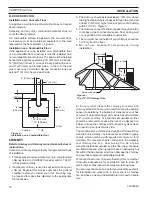
VSW40 Wood Stove
60300060
11
OPERATION
OPERATION
Do not use a grate or elevate fire. Build wood fire directly
on firebrick. When the stove is used for the first time the
solvents in the paint will smoke off.
Wood
This heater is designed to burn natural wood only. Higher
efficiencies and lower emissions generally result when
burning air dried seasoned hardwoods, as compared to
softwoods or to green or freshly cut hardwoods.
Only use dry seasoned wood. Green wood, besides
burning at only 60 percent of the fuel value of dry wood,
deposits creosote on the inside of your stove and along the
chimney. This can cause an extreme danger of chimney
fire. To be called “seasoned,” wood must be dried for
a year. Regardless of whether the wood is green or
seasoned, it should be stored in a well-sheltered ventilated
area to allow proper drying during the year to come. Wood
should be stored beyond recommended clearance from
combustibles.
Fuel
Even the best stove installation will not perform well with
poor fuel. If available, always use hardwood that has been
air-dried (seasoned) 12-18 months. Softwood burns more
rapidly than hardwood and has a high pitch content that
can result in creosote. Decayed wood of any type has little
heat value and should not be used.
Unseasoned (green) wood has a high moisture content.
Much of its heat value will be used to evaporate moisture
before the wood can burn. This significantly reduces the
amount of energy available to warm your home, as well
as the intensity of the fire and temperature of the exhaust
gas. Incomplete combustion and cool flue temperatures
promote creosote formation and weak draft.
You can judge the moisture content of wood by its
appearance and weight or use a commercially available
moisture meter for exact measurement. Unseasoned wood
will be a third heavier than dry wood. Also look for cracks
(checking) in the ends of the log that result from contraction
as the wood dries. The longer and wider the cracks are,
the dryer the wood is.
Creosote
Creosote is a by-product of low-temperature stove operation,
weak draft or both. It is a tar that results when unburned
gases condense inside the flue system at temperatures
below 290 degrees F. Creosote is volatile and can generate
a chimney fire. All of the installation characteristics that
adversely affect chimney draft also promote creosote
condensation. Consequently, you can minimize creosote
accumulation with an effective chimney design and the use
of operational techniques that encourage good draft and
complete combustion.
Inspect your chimney frequently and clean it whenever
accumulation exceeds 1/4".
dO NOT BURN:
Treated Wood, Solvents, Trash, Coal,
Garbage, Cardboard, Colored Papers
NEVER USE GASOLINE, GASOLINE-TYPE LANTERN
FUEL, kEROSENE, ChARCOAL LIGhTER FLUId, OR
SIMILAR LIQUIdS TO START OR “FREShEN UP” A
FIRE IN ThIS hEATER. kEEP ALL SUCh LIQUIdS
WELL AWAY FROM ThE hEATER WhILE IT IS IN USE
INSTRUCTION FOR FIRST BURN – CURING
ThE STOVE PAINT
Your stove has been painted with the highest quality stove
paint and has special break-in procedures. The heat
generated by the normal operation of the stove, will serve
to harden the paint.
Ventilate the house
during the first three times the
stove is used. The paint on the stove will give off smoke,
carbon dioxide and an odor. Without adequate ventilation,
concentrations of smoke could irritate, or be upsetting.
Open doors and windows and use a fan
if necessary.
After the initial burns the paint will be cured and there
should be no more smoke. Each of the initial burns should
be conducted as follows:
1. The first 2 burns should be at approximately 250° F
(120° C) for approximately 20 minutes.
2. The 3
rd
burn should be between 500° F and 700° F
(260° to 370° C) for at least 45 minutes. The important
fact is the paint should be cured slowly. Avoid hot fires
during the curing process.
The best way to achieve the first burn is with kindling fires.
Prolong the fires as needed by adding more kindling.
During the curing process the paint may be gummy. Once
cured the paint will remain hard.
It is normal
to see flat
spots on painted surfaces of the stove. The flat spots on
the paint surface indicate the hotter surfaces of the stove,
and is caused by the heat radiating through the paint.
It is
also expected that shiny spots
caused by friction from
the packaging materials, will disappear during the curing
of the stove.
So . . .
1. Remember to ventilate well.
2. Allow the stove to cure before burning for long periods
at high temperatures.
3. Flat spots on the painted surfaces are normal.
4. Shiny spots on the paint surface before burning is
normal.
5. Call your dealer if you have any questions.






































